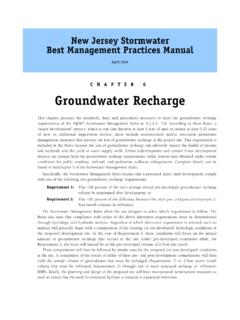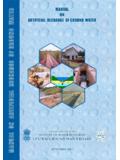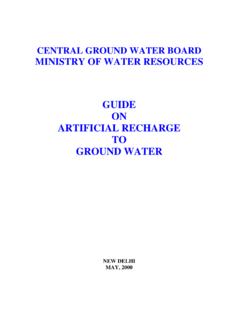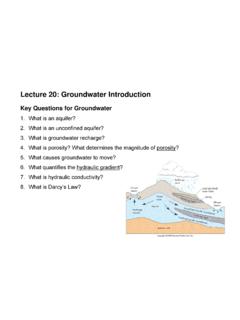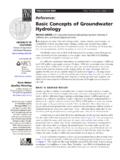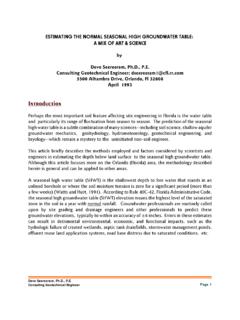Transcription of Western Cape Unit - Geoscience
1 1 Western Cape Unit Box 572 Bellville 7535 SOUTH AFRICA c/o Oos and Reed Streets Bellville Cape Town Reception: +27 (0) 21 946 6700 Fax: +27 (0) 21 946 4190 groundwater vulnerability map for South Africa C. Musekiwa and K. Majola Council for Geoscience Report number: 2011-0063 Copyright 2011. Council for Geoscience 2 Contents 1 Introduction to groundwater vulnerability assessment ..4 2 3 Regional groundwater vulnerability assessment in South Africa ..8 Regional groundwater vulnerability using Other methods for vulnerability assessment in South Africa ..10 4 Rating of Weighting of 5 Datasets ..12 Depth to water table ..12 Net Aquifer Soil media.
2 15 Topography (slope)..17 Impact of the vadose zone ..18 Hydraulic Land 6 7 8 Limitations of vulnerability assessment 9 References ..26 Figures Figure 1: Depth to groundwater Figure 2: Recharge map 3 Figure 3: Aquifer media map of South Africa..15 Figure 4 : Soil texture Figure 5: Slope classes used for the study Figure 6: The different classes for the impact of the vadose zone Figure 7: Generalised land use map of South Figure 8: The resulting vulnerability map of South Africa..22 Figure 9: Average NO3+NO2 as N greater than 10 mg/L per sampling station until 2008 (from Maherry et al., 2010)..24 Figure 10: Average NO3+NO2 as N greater than 50 mg/L per National Landcover 2000 class (from Maherry et al.)
3 , 2010)..24 Figure 11: Comparison of vulnerability and EC maps for South Figure 12: The vulnerability map available in South Africa..26 Tables Table 1: Summary of data type required for vulnerability assessment (modified from Civita, 1993)..6 Table 2: Description of parameter weights used when assessing groundwater Table 3: Ratings assigned to groundwater vulnerability parameters (Lynch et al., 1994) ..9 Table 4: Ranking for the depth to Table 5: Ratings and weights for the recharge in the study Table 6: The different aquifer types and their ratings and weights ..14 Table 7: Weights and ratings assigned to the different soil types (Sa = sand, Lm = loam, Cl clay and the number represents the proportion of each soil type in the area).
4 16 Table 8: Slope classes and their weights and Table 9: The ratings for the impact of the vadose zone Table 10: The ratings and weights for the hydraulic conductivity of different aquifer types ..20 Table 11: The ratings and weights for the land 4 1 Introduction to groundwater vulnerability assessment Vulnerability of groundwater is a relative, non-measurable, dimensionless property (IAH, 1994). It is based on the concept that some land areas are more vulnerable to groundwater contamination than others (Vrba and Zaporozec 1994). Maps showing groundwater vulnerability are useful in planning, policy and decision-making process concerning groundwater management and protection.
5 They also help with identification of areas more susceptible to contamination than others. Overlaying these maps with maps showing the location of each contamination source or land use enables the creation of risk maps (Gogu and Dassargues, 2000). There are various methods for assessing groundwater vulnerability and the main ones are described in Gogu and Dassargues, 2000. These include SINTACS, GOD, SEEPAGE, the AVI Rating system, ISIS, EPIK and DRASTIC. DRASTIC has been identified as the most appropriate method since it is suitable for regional applications and the required input data was accessible (Berkhoff, 2008). For this reason, only the DRASTIC method for groundwater vulnerability assessment was employed in this investigation.
6 Additional information on the alternative methods is provided in Gogu and Dassargues (2000). 2 DRASTIC DRASTIC is a model for evaluating pollution potential of large areas and its name is an acronym derived from seven parameters required for its use. These are: Depth to water table Recharge (net) Aquifer media Soil media Topography Impact of the vadose zone Conductivity (Hydraulic) DRASTIC involves the overlay of various hydrogeological settings available, which could describe soil type, bedrock type, rainfall and net recharge estimate, aquifer yield and any other features associated with the setting (Piscopo, 2001). Table 1 summarises the type of data required and this is also discussed in more detail in the following paragraphs.
7 The depth to water is the distance the contaminant has to travel before reaching the aquifer and indicates the contact time with the surrounding media. In a confined aquifer, due to the low 5 permeability of the confining media, the travel of contaminants is slowed down and the contaminants cannot easily reach the aquifer. These types of aquifers are therefore less vulnerable to pollution when compared to unconfined aquifers (Hasiniaina et al., 2010). Recharge indicates the amount of water per unit area of land penetrating the ground surface and reaching the water table (Aller et al., 1987). This water is therefore available to transport a contaminant vertically to the water table and horizontally within the aquifer.
8 The quantity of water available for dispersion and dilution in the aquifer is controlled by this recharge. Recharge to the aquifer occurs more readily in an unconfined aquifer and therefore the pollution potential is greater than in confined aquifers. In some confined aquifers, the movement of water might be through the confining bed from the confined aquifer into the unconfined aquifer. In such a case, there is small opportunity for local contamination. Some confined aquifers are partially recharged by the movement of water through the confining bed, the more the water, the greater the potential for recharge to carry pollution into the aquifer (Aller et al.)
9 , 1987) An aquifer is a rock formation which will yield sufficient water quantities for use. Rocks which produce water from pore spaces have primary porosity and those where water is held in fractures, for example, have secondary porosity (Aller et al., 1987). The aquifer media describes the characteristics of the aquifer and is vital in groundwater vulnerability assessment in addition to determining the flow of water. The aquifer media determines the permeability and the porosity of the medium which the contaminant is in contact with in the aquifer and these affect the route and path length the contaminant must follow.
10 The path of groundwater flow is also affected by the fractures in the aquifer. More fractures would increase the vulnerability to pollution (Hasiniaina et al., 2010). The contaminant first passes through the soil when it seeps into the ground. The soil media affects the recharge and the contaminant movement. Fine textured materials such as silts and clays restrict contaminant migration and decrease soil permeability. These areas have lower vulnerability when compared to gravels and sands for example which are highly permeable (Hasiniaina et al., 2010). The topography, referring to the slope and slope variability of the land surface, affects groundwater vulnerability.


